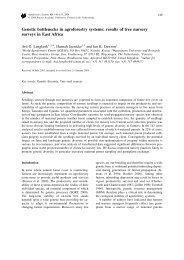A Phylogenomic Study of Birds Reveals Their Evolutionary History
A Phylogenomic Study of Birds Reveals Their Evolutionary History
A Phylogenomic Study of Birds Reveals Their Evolutionary History
Create successful ePaper yourself
Turn your PDF publications into a flip-book with our unique Google optimized e-Paper software.
REPORTSwithin Struithioniformes (ostriches and allies;purple, node Q, Fig. 2), (ii) Apodiformes (hummingbirdsand swifts) are found within Caprimulgiformes(nightjars and their allies; brown,node L, Fig. 2), and (iii) Piciformes are found withinCoraciiformes (node C, Fig. 2). Typical Pelecaniformesand Ciconiiformes [sensu (13, 25)]were intermixed in a clade (Fig. 2) that excludesone traditional pelecaniform family: the Phaethontidae(tropicbirds). The Gruiformes represented atleast four distinct clades in our tree (Fig. 4), dependingon the circumscriptions <strong>of</strong> this order[reviewedin(6)]. Finally, Falconidae and Accipitridae(hawks and osprey) formed distinct clades inall analyses, rather than a monophyletic Falconiformes(Fig. 2) (18).Several disparate taxa were robustly placed inour analyses. Cariamidae (seriemas) has traditionallybeen classified as a gruiform, althoughconvergence with Falconiformes was noted (6).We found strong support for placing Cariamidaewithin land birds near other raptorial groups.Leptosomus (cuckoo roller) is generally placedwithin Coraciiformes, though a relationship withFalconiformes has also been suggested (6). Ourdata set placed Leptosomus sister to a clade includingPiciformes, Coraciiformes, and Trogoniformes(node D, Fig. 2).Our results suggest resolution <strong>of</strong> some controversialgroupings. For example, Cathartidae (NewWorld vultures)—traditionally placed withinFalconiformes—were previously allied with Ciconiidae(storks) (6). However, our phylogenydemonstrated no affinity with storks [see also(3, 18, 26)] and instead strongly supportedplacement <strong>of</strong> Cathartidae within the land birds(usually with Accipitridae). We support that Turnix(buttonquail) belongs within the Charadriiformes(3, 4, 27) and that Podicipediformes (grebes) andPhoenicopteriformes (flamingos; node N, Fig. 2)(14) are sister taxa. Finally, we recovered a sisterrelationship between Rhynochetos (kagu) andEurypyga (sunbittern) (node M, Fig. 2) (28): twomonospecific and geographically disparate familiesthat grouped outside <strong>of</strong> the core Gruiiformes.The previously proposed division <strong>of</strong> Neoavesinto Coronaves and Metaves is driven by two loci(4) in our analyses (Fig. 1) and may not representthe species tree. Many taxa assigned to Metavesare composed <strong>of</strong> small numbers <strong>of</strong> closely relatedextant species, including Mesitornithidae (mesites),Phaethontidae, Pteroclididae (sandgrouse),and Columbiformes (pigeons and doves). The difficultyinplacingthemmaybedrivenbylong,unbreakable branches leading to the tips (Fig. 3).The enigmatic Opisthocomus (hoatzin) still cannotbe confidently placed, but some putative sisterrelationships can be rejected (29).Modern birds occupy a wide diversity <strong>of</strong>niches and exhibit a variety <strong>of</strong> behaviors. Thebroad structure <strong>of</strong> our phylogeny suggested diversificationalong general ecological divisions,such as water birds, shorebirds, and land birds.However, adaptations to these environments clearlyarose multiple times (4), because many aquaticbirds were not part <strong>of</strong> the water bird clade (e.g.,tropicbirds, flamingos, and grebes) and terrestrialbirds were found outside <strong>of</strong> the land bird clade(e.g., turacos, doves, sandgrouse, and cuckoos).Our phylogeny also indicated several distinctiveniches, such as nocturnal (owls, nightjars, andallies), raptorial (falcons, hawks, eagles, NewWorld vultures, seriema, and owls), or pelagic(tubenosed birds, frigatebirds, and tropicbirds)lifestyles, have evolved multiple times. Furthermore,our results reinterpret the evolution <strong>of</strong>various adaptations (e.g., the diurnal Apodiformesevolved from nocturnal/crepuscular Caprimulgiformes,and flighted Tinamiformes arosewithin the flightless Struthioniformes) and biogeographicpatterns (e.g., the New Caledoniankagu and Neotropical sunbittern are sister taxa).Given the number <strong>of</strong> nonmonophyletic groupsin our study, we compared our results withmajor classifications [supporting online material(SOM) text]. Unexpectedly, roughly thesame percentage (35%) <strong>of</strong> orders defined bydifferent classifications (13, 25, 30) was notmonophyletic relative to the results <strong>of</strong> our study(Fig. 4). Some orders, such as Gruiformes andthe broadly encompassing Ciconiiformes [sensu(30)], were particularly problematic. Other traditionalorders were not monophyletic because<strong>of</strong> the exclusion or inclusion <strong>of</strong> one ora few taxa (e.g., placing Turnix within Charadriiformescontradicts all three classifications).Only six orders were defined consistentlyacross taxonomies and monophyletic in ourstudy (Fig. 4). Given our results, conclusionsfrom comparative studies that dependedupon these classifications may need to bere-evaluated in light <strong>of</strong> this understanding <strong>of</strong>avian evolution.Deciphering the roots <strong>of</strong> the avian tree <strong>of</strong>life has been a lingering problem in evolutionarybiology. The inclusion <strong>of</strong> multiple lociwith diverse rates <strong>of</strong> evolution, particularlythe large proportion <strong>of</strong> rapidly evolving introns,yielded a well-supported phylogenetictree at multiple taxonomic depths. Althoughsome higher-level avian relationships remainunresolved, simulations suggest that additionalsequence data from rapidly evolving locimay resolve these remaining questions (1). Itis also evident that future classifications will0.1Fig. 3. ML phylogram demonstrating the short internodes at the base <strong>of</strong> Neoaves and highlightingcertain extreme examples <strong>of</strong> rate variation across avian lineages. Colors are as in Fig. 2. Scale barindicates substitutions per site. Figure S1 shows the phylogram with taxon names.Downloaded from www.sciencemag.org on August 29, 2008176627 JUNE 2008 VOL 320 SCIENCE www.sciencemag.org



